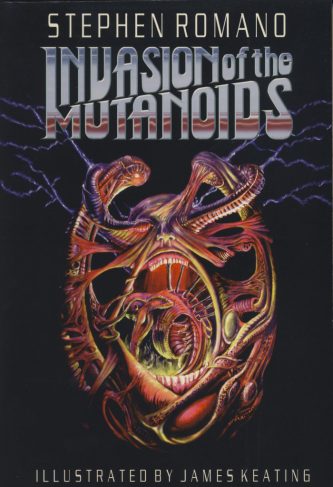 By STEPHEN ROMANO (Animated Alligator; 1997)
By STEPHEN ROMANO (Animated Alligator; 1997)
This novel, the first by Stephen Romano, is known today (if at all) for the mention it received in Romano’s 2008 SHOCK FESTIVAL, in whose pages INVASION OF THE MUTANOIDS is dismissed as “embarrassing.” Romano has further derided it as “terrible” and a “student novel,” and after reading through its overwrought 358 pages I’ll have to concur. Yet MUTANOIDS isn’t entirely without interest, it being the most over-the-top alien invasion themed splatter-thon I’ve ever encountered. That Romano had a talent for visceral prose is evident throughout, even if that talent was just as evidently in its embryonic stages.
The insanely complex (and only semi-coherent) plot involves an invasion by shape-shifting “mutanoids” controlled by a being known as The Master—apparently an “insidious criminal element that has plagued the universe for centuries”—who infects both people and objects. The “hero” is Ozzy, a trigger-happy escaped con whose mind The Master can’t penetrate, seeing as how Ozzy is too drug-addled and psychotic. This leads to lots and lots of over-the-top action in which Ozzy is pursued by everything from a bodysnatched gas station attendant to a fang-sprouting car to a quartet of alien gunmen who wield large penis guns.
Ozzy is saved from certain death by a rival alien presence known as Riel. On Riel’s planet Ozzy is transformed into a partial cyborg and then sent back to Earth to halt the mutanoid invasion. But this time around Ozzy discovers The Master is just one of several Masters who are in cahoots with dangerous inter-dimensional beings created by Alica, a dead science fiction novelist. Thwarting this new threat involves traveling into an alternate reality peopled by characters and décor from Alica’s fiction. It’s here that all the protagonists—including Alica’s grief-stricken father, who’s determined to avenge his son’s untimely death–converge in the futuristic city of New Houston.
That, keep in mind, is a very abbreviated summary of a frequently confusing and top-heavy narrative. Storytelling clearly wasn’t among the young Stephen Romano’s strong points, although he does demonstrate a laudable willingness to tweak convention in his multiple narrative strands, which include a lengthy excerpt from the novel-within-the-novel that provides much of the impetus for INVASION OF THE MUTANOIDS’ second half. Where Romano really excels is in kinetic descriptions of flesh ripping, mutation and cybernetic surrealism, which are all-but continuous—and also a bit monotonous in their unvarying top-of-the-voice tone. Restraint was something else Romano evidently had yet to learn.
The book, it must be said, is beautifully designed, and contains a wealth of nifty black and white illustrations by James Keating. Graphically striking and densely detailed, Keating’s draftsmanship makes for a perfect companion to the over-the-top craziness of Romano’s writing; in fact, I’d venture to say that the MUTANOIDS artwork actually outdoes the prose.
